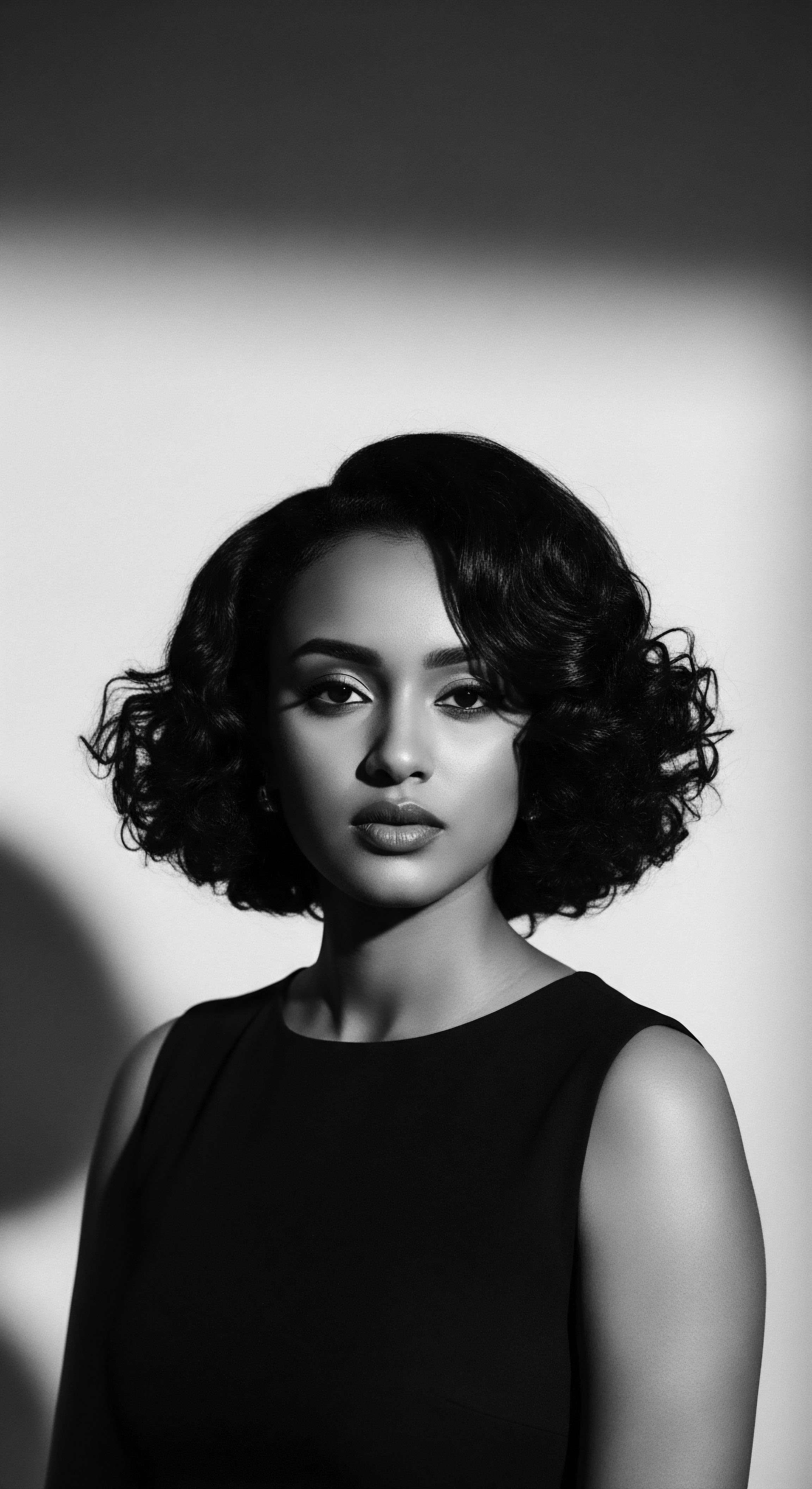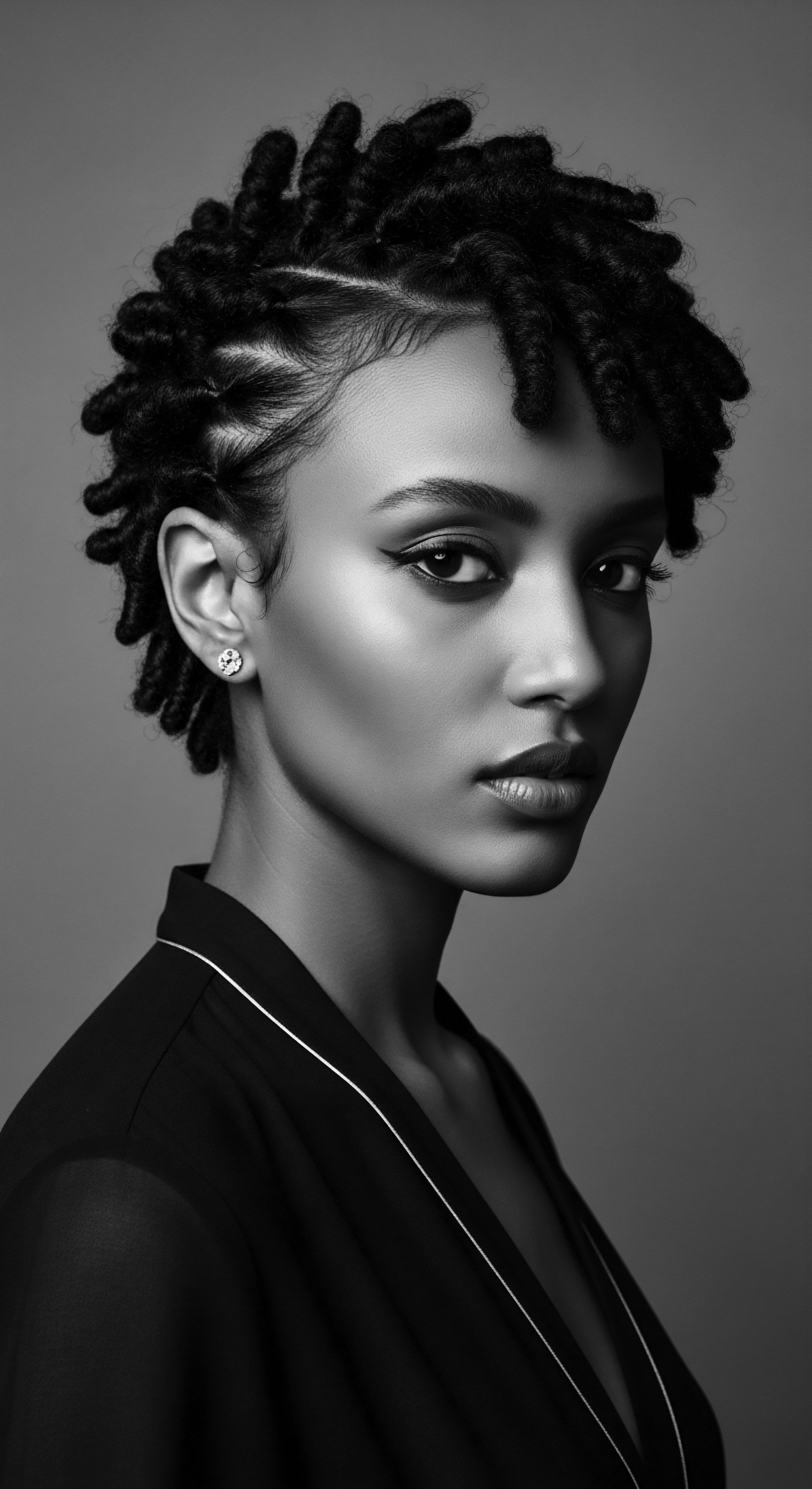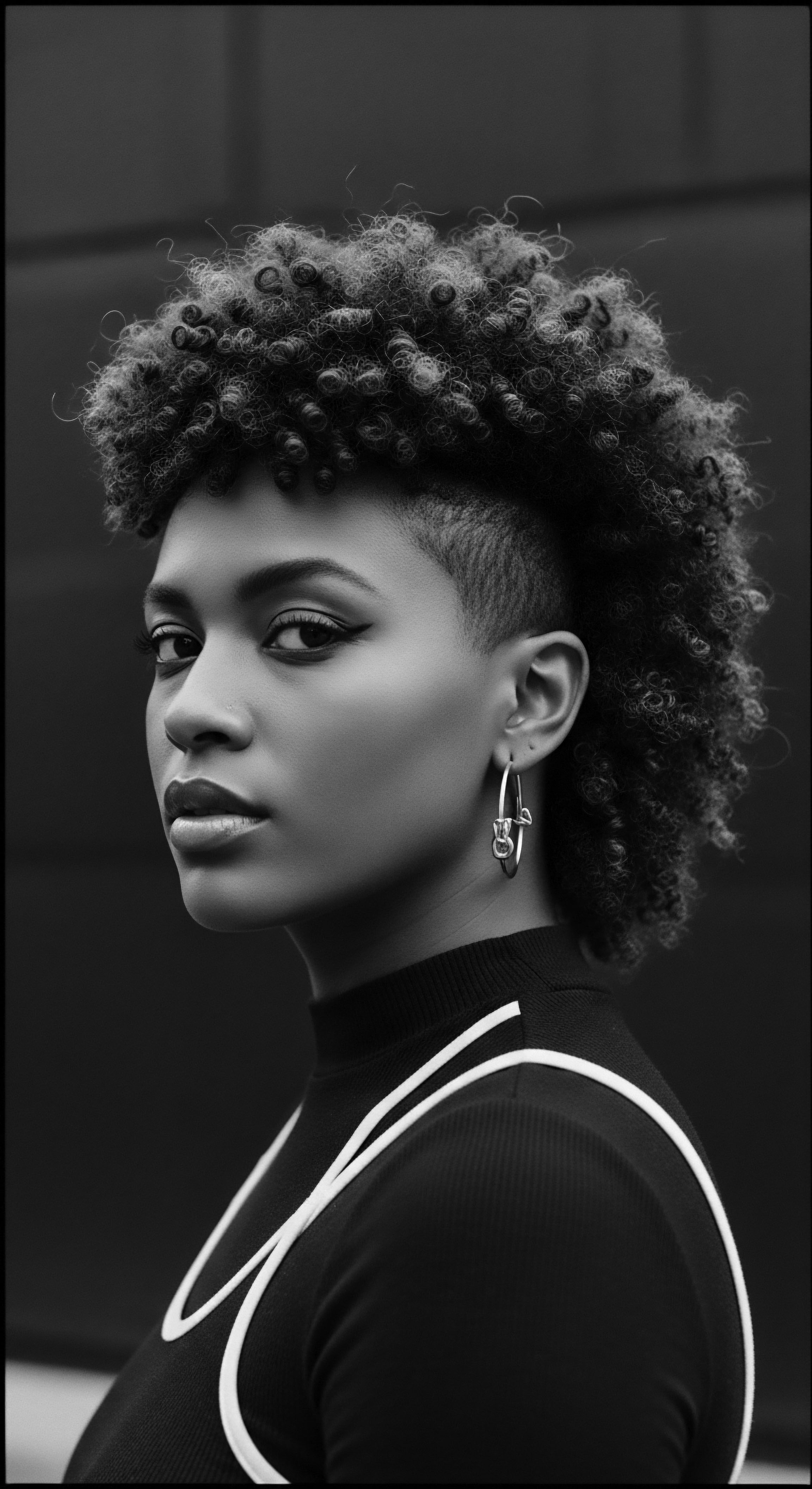
Roots
The story of textured hair, coily and curly strands, is written in spirals, a lineage tracing back through millennia. It is a heritage of resilience, of unique beauty, and of profound connection to the earth’s offerings. To truly understand how the fatty acids in shea butter nourish these crowns, we must first listen to the whispers carried on ancestral winds. This knowledge is not merely scientific; it is a profound echo from the source, from lands where the Vitellaria paradoxa, the shea tree, has stood as a silent witness to generations of care.
Consider the hands that first worked the shea nut, centuries ago, in the vast savanna lands of West and Central Africa. These hands, often belonging to women, understood a deep kinship with nature’s abundance. They saw in the shea fruit a promise of sustenance and protection, extracting its golden butter through meticulous, time-honored methods. This traditional process, involving hand-harvesting, sun-drying, grinding, roasting, and patient boiling, preserved the butter’s potent properties, a legacy passed from elder to youth.
The butter was not simply a commodity; it held ceremonial significance, often called “women’s gold” for its economic role and sacred standing as a symbol of fertility and purity. Its application transcended mere aesthetics, a balm for skin against harsh climates and a shield for hair, embodying a holistic approach to well-being that intertwined body, spirit, and community.

The Hair’s Intricate Architecture
Coily and curly hair, distinct in its helical structure, possesses a unique architecture. Unlike straighter hair types, the elliptical cross-section and varied curl patterns of these strands mean their outer layer, the cuticle, is often more raised. This characteristic, while contributing to the hair’s magnificent volume and expressive shape, also means moisture can escape more readily, making these hair types prone to dryness and susceptibility to external elements. This inherent nature is why practices centered on moisture retention have been central to textured hair care across generations and continents.
Ancestral hands understood the protective power of shea, long before science named its compounds.
The very shape of a coily strand, with its twists and turns, creates points of vulnerability. These curves act as natural breakpoints, where the hair shaft can weaken if not adequately lubricated and reinforced. The traditional use of rich emollients, like shea butter, speaks to an inherited understanding of this structural reality. It was an intuitive science, a knowledge gleaned from observation and communal practice, long before microscopes revealed the secrets of the hair shaft.

An Ancestral Lexicon of Care
The language of textured hair care, especially regarding traditional practices, is rich with terms that speak to deep cultural understanding. We find expressions for protective styles that guarded fragile strands, for communal grooming rituals that built bonds, and for natural ingredients that served as the very foundation of hair health. These ancestral terms, often specific to various African ethnic groups, reflect a nuanced approach to hair that recognized its connection to identity, status, and spirituality. The application of butters and oils was an act of reverence, a testament to the hair’s place as a cherished extension of self.
- Ori ❉ A Yoruba term for shea butter, signifying its importance beyond just a cosmetic ingredient, pointing to its spiritual and cultural value.
- Hair Greasing ❉ A historical practice in African American communities, rooted in African traditions, involving the application of oils and butters to the scalp and hair for moisture and protection.
- Kukui Nut Oil ❉ While from Hawaii, its traditional use mirrors shea butter’s role as a protective and moisturizing agent for textured strands in diverse island communities.

Ritual
The daily and ceremonial interactions with hair, particularly coily and curly patterns, have always been more than routine; they are rituals. These practices, honed over generations, exemplify a deep understanding of hair’s needs. The fatty acids in shea butter have played a central role in these heritage rituals, providing a tangible link between ancient wisdom and contemporary care.

What Role Do Stearic and Oleic Acids Play in Hair?
Shea butter is a complex gift from the earth, its benefits residing significantly within its fatty acid profile. The principal components, Stearic Acid and Oleic Acid, are remarkable. Stearic acid, a saturated fatty acid, is responsible for shea butter’s solid consistency at room temperature. When applied to hair, its molecular structure allows it to create a protective barrier on the strand’s surface, effectively sealing the cuticle.
This barrier acts as a shield, minimizing moisture loss and defending against environmental aggressors. This physical protection is particularly beneficial for coily and curly hair, which, due to its raised cuticles, can easily lose hydration. Think of it as a gentle, breathable cloak, safeguarding each coil from the elements.
Oleic acid, a monounsaturated fatty acid, holds a different but equally significant role. It is a lighter, more liquid component compared to stearic acid. Its structure allows it to penetrate the hair shaft more readily, carrying nourishing compounds deeper into the hair’s cortex. This deep penetration ensures that the strand receives hydration from within, promoting elasticity and suppleness.
The combination of stearic acid’s sealing ability and oleic acid’s penetrating power creates a dual-action nourishment system that has been intuitively utilized in ancestral hair care for millennia. This scientific validation of long-standing practices underscores the profound wisdom held within traditional methods.

How Does Linoleic Acid Aid Hair Elasticity and Strength?
Beyond stearic and oleic acids, shea butter also contains a notable amount of Linoleic Acid, an omega-6 essential fatty acid. This polyunsaturated fatty acid is particularly valuable for maintaining the hair’s overall health and vitality. Linoleic acid supports the hair’s natural barrier function, contributing to its moisture retention capabilities.
For coily and curly hair, which often battles dryness and brittleness, linoleic acid helps to strengthen the hair fiber from within, making it more resilient to breakage. It is a building block for healthy hair, promoting a pliable strand that can withstand the movements and styling intrinsic to textured hair.
The interplay of shea butter’s fatty acids forms a harmonious shield and an inner balm for hair.
This fatty acid also plays a part in supporting scalp health, which is a critical, often overlooked aspect of hair care. A healthy scalp lays the groundwork for robust hair growth. When the scalp is well-nourished and balanced, it provides an optimal environment for hair follicles to thrive. The soothing properties of shea butter, partly attributed to its fatty acid profile, can help reduce scalp irritation, creating a calm foundation for hair’s journey.
| Fatty Acid Stearic Acid |
| Traditional Understanding/Observed Effect Provided a visible protective coating, kept hair soft and shielded from sun and dust. |
| Modern Scientific Role for Hair Forms a protective barrier, reducing transepidermal water loss and sealing the cuticle. |
| Fatty Acid Oleic Acid |
| Traditional Understanding/Observed Effect Helped other ingredients absorb, made hair feel soft and less stiff. |
| Modern Scientific Role for Hair Penetrates the hair shaft to provide deep hydration and carries other nutrients into the cortex. |
| Fatty Acid Linoleic Acid |
| Traditional Understanding/Observed Effect Contributed to hair's suppleness, reduced brittleness during styling. |
| Modern Scientific Role for Hair Reinforces the hair's natural barrier, enhancing moisture retention and elasticity. |
| Fatty Acid The enduring wisdom of traditional African hair care finds affirmation in the molecular composition of shea butter. |

Relay
The journey of shea butter, from its ancestral roots in West African communities to its recognition in global hair care, signifies a relay of profound knowledge. This knowledge, carried through generations, speaks to a consistent understanding of how this plant butter profoundly nourishes coily and curly hair patterns. We now look to research and studies that affirm what has been known and practiced for centuries.

Understanding Penetration and Protection
The effectiveness of shea butter on textured hair patterns stems from a unique interplay of its fatty acids with the hair’s structure. Coily and curly hair, characterized by its natural inclination towards dryness due to the irregular distribution of natural sebum along the spiraling strand, presents specific challenges. The ability of shea butter’s fatty acids to both penetrate the hair shaft and form a protective film on the surface is a dual action that addresses these particular needs. Research indicates that the lipid profile of shea butter, especially its balanced ratio of oleic and stearic acids, contributes to its remarkable conditioning properties.
Oleic acid, with its relatively smaller molecular size, can pass through the cuticle layers, delivering hydration directly to the hair’s cortex. Stearic acid, on the other hand, being a longer-chain saturated fatty acid, creates a hydrophobic layer on the hair’s exterior, preventing moisture from escaping and offering a degree of environmental protection. This dual function is a scientific validation of the traditional understanding of shea butter as both a softener and a sealant.
This protective quality is particularly pertinent when considering the environmental conditions historically faced by communities in the ‘shea belt’ regions of Africa. The shea tree thrives in the hot, often arid savanna climates. For generations, women used shea butter to shield their skin and hair from intense sun, wind, and dust.
This ancestral wisdom of using shea as a natural shield is directly linked to the UV-absorbing properties of its cinnamic acid esters, a non-saponifiable component found in shea butter. While not a primary fatty acid, its presence alongside the fatty acids contributes to the overall protective matrix.

Case Study Echoes ❉ The Tungteiya Women’s Shea Butter Association
To appreciate the enduring impact of shea, one might consider the Tungteiya Women’s Shea Butter Association in Ghana. This cooperative, comprising approximately 500 women, employs traditional techniques, inherited through generations, to process shea kernels. Their work not only sustains livelihoods but also preserves ancestral methods of shea butter production. The economic empowerment that arises from the shea industry, predominantly managed by women, is a historical and contemporary testament to its value.
Annually, approximately 16 million women across 21 African countries depend on the shea tree for their livelihood. This widespread engagement, often rooted in traditional processing, underscores the butter’s deep socio-economic and cultural significance, extending its influence far beyond its direct cosmetic application. The success of such associations provides concrete evidence of how a natural resource, understood and processed through generational knowledge, continues to nourish communities, literally and figuratively, connecting the economic sustenance of women with the sustenance of textured hair. This provides a compelling example of the inherent value in preserving these heritage practices.
The journey of shea butter from ancestral hands to global recognition is a continuous unfolding of natural wisdom.

Holistic Care and Scalp Wellness
The fatty acids in shea butter also contribute to a healthy scalp environment, which is paramount for the vitality of coily and curly hair. The anti-inflammatory properties attributed to shea butter can help soothe scalp irritation, a common concern for many with textured hair. An irritated or dry scalp can hinder hair growth and contribute to issues such as flaking. By providing deep hydration and reducing inflammation, the fatty acids like oleic and linoleic acid help to maintain a balanced scalp microbiome, ensuring hair follicles receive optimal nourishment.
This understanding aligns with ancestral wellness philosophies, which often viewed hair health as an integral component of overall bodily harmony. Traditional hair rituals frequently included scalp massages with shea butter, not only for hair strength but also for their calming effect, demonstrating an intuitive grasp of this connection between scalp wellness and hair prosperity.
The very consistency of shea butter, particularly raw, unrefined varieties, allows for a deliberate, mindful application. This tactile experience, a gentle kneading of the rich butter into the scalp and along the strands, mirrors the historical practices of care. It is a slow beauty, a moment of connection with a tradition that holds reverence for the strands, recognizing them as carriers of identity and heritage. The benefits of shea butter extend beyond the chemical composition; they reside in the ritual, the intention, and the profound connection to ancestral wisdom.
- Unrefined Shea Butter ❉ Retains the highest concentration of vitamins, minerals, and fatty acids, mirroring the traditional form used by ancestral communities.
- Scalp Massage ❉ An ancient practice across various African cultures, enhanced by shea butter’s soothing fatty acids, promoting blood flow and nutrient delivery to follicles.
- Protective Styling Support ❉ Historically, shea butter softened hair for braiding and twisting, styles that shielded textured hair; its fatty acids still support the integrity of these protective patterns today.

Reflection
The journey through the profound connection between shea butter’s fatty acids and the nourishment of coily and curly hair patterns closes where it began ❉ with the deep, resonant hum of heritage. Each twist, each coil, carries stories—stories of resilience, adaptation, and an unwavering commitment to self-care, shaped by ancestral hands and wisdom. The scientific explanations of stearic, oleic, and linoleic acids merely affirm what grandmothers and healers in West Africa knew in their bones for centuries ❉ this golden butter held secrets to enduring vitality for hair that mirrored the very spirit of its people.
This is more than simply understanding cosmetic ingredients; it is about honoring a living archive. The fatty acids in shea butter are threads within a larger cultural narrative, a testament to how traditional knowledge, often passed through oral histories and lived practices, contains truths that modern science now seeks to articulate. Our hair, particularly our textured hair, is a powerful conduit to this heritage. When we reach for shea butter, we are not just hydrating our strands; we are engaging in a dialogue with our past, affirming the beauty of our lineage, and continuing a tradition of self-reverence.
The ‘Soul of a Strand’ whispers that true hair care transcends the superficial; it is a sacred act of remembering, a celebration of inherited strength, and a conscious choice to uphold the legacy of those who came before us. This legacy, rich with the gifts of the earth, continues to guide us toward a path of authentic care and profound self-acceptance.

References
- Abbiw, D. K. (1990). Useful Plants of Ghana ❉ West African Uses of Wild and Cultivated Plants. Intermediate Technology Publications.
- Bounkoungou, E. G. Bayen, P. & Kalinganire, A. (1998). The Shea Tree (Vitellaria paradoxa Gaertn. f.) in Burkina Faso ❉ Its Economic Importance, Production and Prospects for Improved Management. ICRAF.
- Gwali, S. Okullo, J. B. L. Eilu, G. Nakabonge, G. Nyeko, P. & Vuzi, P. (2011). Folk Classification of Shea Butter Tree (Vitellaria paradoxa subsp. nilotica) Ethno-varieties in Uganda. Ethnobotany Research & Applications, 9, 243-256.
- Hemsley, J. H. (1968). Vitellaria paradoxa. Royal Botanic Gardens, Kew.
- Jiofack, T. Fokunang, C. Guedje, N. Kemeuze, V. Fongnzossie, E. Nkongmeneck, B. A. Mapongmetsem, P. M. & Tsabang, N. (2009). Ethnobotanical Survey of Medicinal Plants Used in the Traditional Treatment of Diabetes Mellitus in Cameroon. Journal of Ethnopharmacology, 124(3), 444-453.
- Lamien, N. Ziba, B. & Yameogo, G. (1996). Vitellaria paradoxa ❉ A Monograph. CIRAD-Forêt.
- Lovett, P. N. & Haq, N. (2000). Diversity of the Shea Nut (Vitellaria paradoxa CF Gaertn.) in Ghana. Economic Botany, 54(1), 58-67.
- Lovett, P. N. (2014). Natural Butters Fractionation Alternatives. Personal Care Asia Pacific, Waxes and Butters .
- Maanikuu, I. & Peker, H. (2017). A Review of the Chemical Composition and Therapeutic Properties of Shea Butter. Journal of Immunobiology, 3(1), 1-8.
- Maranz, S. & Wiesman, Z. (2023). Shea Butter ❉ A Review. Academic Press.
- Maranz, S. Wiesman, Z. Bisgaard, B. & Frette, C. (2004). Germination and Seedling Growth of Vitellaria paradoxa C.F. Gaertn. ( Shea Nut Tree ) from West and Central Africa. Agroforestry Systems, 60(3), 209-218.
- Mensink, R. P. (2005). Effects of Saturated Fatty Acids on Serum Lipids and Lipoproteins. Current Opinion in Lipidology, 16(1), 17-21.
- Nwachi, N. T. & Ogba, P. C. (2022). Phytochemical and Nutritional Properties of African Shea Butter (Vitellaria paradoxa). International Journal of Research and Innovation in Applied Science, 7(12), 162-166.
- Rajbonshi, R. (2021). Shea Butter ❉ A Review on its Traditional Uses, Chemical Constituents and Pharmacological Activities. International Journal of Pharmaceutical Sciences Review and Research, 66(1), 143-148.
- T. Islam. (2017). The Science of Hair Care. CRC Press.
- Ziba, B. & Yameogo, G. (2002). The Shea Tree (Vitellaria paradoxa C.F. Gaertn.). IPGRI.
